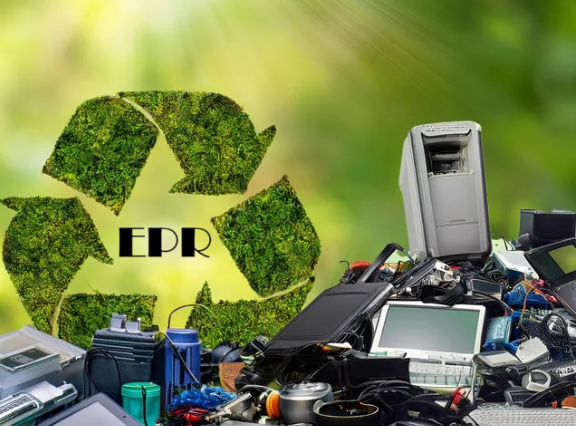Electronic waste (e-waste), comprising discarded electrical and electronic devices, is the fastest-growing waste stream globally. India, being one of the largest consumers of electronic products and third-largest generator of e-waste worldwide, faces a critical challenge in managing this waste responsibly. E-waste management in India not only presents environmental and health risks but also offers opportunities for resource recovery and economic growth. This article explores the scale and risks of e-waste in India, the challenges in its management, and the solutions being adopted to address this pressing issue.
The E-Waste Surge in India
India’s e-waste generation has surged dramatically in recent years. From around 7.08 lakh metric tonnes in 2017-18, it has risen over 150% to an estimated 17.78 lakh metric tonnes in 2023-24. This growth is driven by rapid technology adoption, frequent product obsolescence, and increasing consumer electronics penetration even in smaller cities and towns. E-waste includes a wide variety of items such as mobile phones, computers, televisions, refrigerators, and other household and industrial electrical goods.
Despite this rapid rise, only around 70% of e-waste generated was collected and processed in 2024-25, reflecting significant gaps in collection and recycling infrastructure. Most concerning is that approximately 90-95% of e-waste in India is handled by informal sectors using rudimentary and unsafe methods. This informal recycling sector, dominated by small-scale dismantlers often operating without proper safety gear, exposes workers and the environment to hazardous substances like lead, mercury, cadmium, and other toxic chemicals commonly found in e-waste.
Major Challenges in E-Waste Management
1. Informal Sector Dominance and Unsafe Recycling Practices
The informal recycling sector dominates e-waste processing in India due to its accessibility and cost-effectiveness. However, it relies on harmful techniques such as open burning, acid leaching, and manual dismantling without protective equipment. This causes severe environmental degradation, including air, water, and soil pollution, and poses grave health risks to workers, many of whom are women and children with limited awareness of the dangers.
2. Lack of Consumer Awareness and Incentives
Many consumers in India lack awareness about the hazards of improper e-waste disposal and the availability of formal e-waste collection centers. Additionally, there are limited financial or logistical incentives to encourage responsible disposal, especially in Tier-II and Tier-III cities. As a result, much of the e-waste ends up with informal scrap dealers or is dumped illegally, exacerbating pollution problems.
3. Insufficient Collection Infrastructure
India’s authorized e-waste collection centers and recycling units are insufficient to meet the demands of such a vast and growing waste stream. While efforts have been made to establish collection and recycling hubs, many are concentrated in urban areas, leaving vast regions underserved. The infrastructure also requires modernization to handle the diversity and volume of electronic devices efficiently.
4. Regulatory and Policy Gaps
Although India implemented the E-Waste (Management) Rules and the Extended Producer Responsibility (EPR) framework to assign collection and recycling responsibility to producers and importers, enforcement remains a challenge. The informal sector’s extensive role and incomplete tracking of e-waste flows complicate regulatory oversight. Furthermore, there is a need for more funds and incentives to scale up formal recycling facilities and technology upgrades.
5. Illegal Imports and Grey Market Challenges
India faces challenges linked to illegal import of used electronics, often disguised as donations or second-hand goods. These imports add to the e-waste burden, complicate waste processing efforts, and strain existing facilities.
Environmental and Health Impacts
Improper handling of e-waste leads to the release of toxic substances into the environment. Contaminants can seep into soil and groundwater, affecting agriculture and drinking water supplies. Toxic fumes from burning plastics and metals degrade air quality and increase respiratory diseases. Health implications are severe for workers dismantling e-waste without protection, with studies showing reduced life expectancy and chronic diseases due to prolonged exposure to hazardous substances.
Solutions and Initiatives in E-Waste Management
1. Strengthening Extended Producer Responsibility (EPR)
The government has mandated EPR under the E-Waste Management Rules, 2022, obligating producers, importers, and brand owners to take responsibility for the collection, recycling, and environmentally sound disposal of e-waste generated from their products. This policy instrumentalizes the polluter pays principle and encourages manufacturers to design products for easier recycling and longer life.
2. Formalizing and Upgrading the Recycling Sector
Efforts are underway to formalize the informal e-waste recycling sector by integrating small dismantlers into compliant processes and providing training on safer recycling techniques. Modern recycling facilities employing eco-friendly technologies, such as hydrometallurgical processes for metal recovery, are being developed to increase resource efficiency and minimize harmful emissions.
3. Expanding Collection Centers and Take-Back Programs
To improve e-waste collection, new collection centers are being established across states, with increased emphasis on accessibility in smaller cities and rural areas. Corporate-led take-back initiatives and e-commerce doorstep collection programs are gaining traction, simplifying the disposal process for consumers and promoting circular economy principles.
4. Increasing Consumer Awareness and Incentives
Public awareness campaigns about the importance of responsible e-waste disposal and the health risks of improper recycling are pivotal. Governments, NGOs, and companies are collaborating to educate consumers and provide incentives like exchange offers, discounts, and easy drop-off points that motivate recycling.
5. Technological Innovations in Recycling
Innovative recycling technologies, including automated sorting, hydrometallurgical metal extraction, and eco-friendly dismantling processes, are being adopted to improve efficiency and reduce environmental impact. These technologies enable the recovery of precious metals such as gold, silver, and copper from e-waste, which is economically valuable and reduces reliance on primary mining.
6. Implementation of Digital Tracking and Data Management
To streamline compliance and transparency, India has deployed digital platforms to track e-waste generation, collection, and recycling. The Central Pollution Control Board (CPCB) manages an online EPR e-waste portal where entities involved in e-waste handling must register and report their activities, helping policymakers monitor progress and enforce regulations.
Economic and Environmental Benefits
Effective e-waste management brings multiple benefits. Recovering precious metals from e-waste reduces dependence on mining, conserves natural resources, and lowers greenhouse gas emissions. Formalizing the recycling industry creates green jobs and adds billions to the economy through secondary raw materials. By mitigating environmental pollution, it also reduces healthcare costs and preserves ecosystems.
Case Studies and Successful Models
Cities like Bengaluru and Pune have pioneered formal e-waste collection programs with public-private partnerships, improving collection rates and worker safety. Some companies offer buy-back schemes and refurbishment services, fostering reuse and extending product life cycles. These initiatives demonstrate the potential for scalable solutions aligned with India’s sustainable development goals.
The Road Ahead
India faces a monumental task to manage its e-waste sustainably amid rapid digital growth. Concerted efforts involving government enforcement, industry responsibility, social inclusion of informal workers, technological investments, and consumer engagement are essential. Continued policy refinement and international collaboration can further enhance capabilities.
The government’s target to achieve 70% e-waste collection by 2024-25 is ambitious but critical. Successfully meeting this goal will require scaling infrastructure, enhancing compliance, and innovating solutions to transform India’s e-waste challenge into an opportunity for a circular, sustainable economy.



